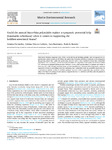Mostrar o rexistro simple do ítem
Could the Annual Saccorhiza Polyschides Replace a Sympatric Perennial Kelp (Laminaria Ochroleuca) When It Comes to Supporting the Holdfast-Associated Fauna?
| dc.contributor.author | Fernández, Cristina | |
| dc.contributor.author | Piñeiro-Corbeira, Cristina | |
| dc.contributor.author | Barrientos, Sara | |
| dc.contributor.author | Barreiro, Rodolfo | |
| dc.date.accessioned | 2023-01-10T19:31:11Z | |
| dc.date.available | 2023-01-10T19:31:11Z | |
| dc.date.issued | 2022-10-22 | |
| dc.identifier.citation | Cristina Fernández, Cristina Piñeiro-Corbeira, Sara Barrientos, Rodolfo Barreiro, Could the annual Saccorhiza polyschides replace a sympatric perennial kelp (Laminaria ochroleuca) when it comes to supporting the holdfast-associated fauna?, Marine Environmental Research, Volume 182, 2022, 105772, ISSN 0141-1136, https://doi.org/10.1016/j.marenvres.2022.105772. (https://www.sciencedirect.com/science/article/pii/S0141113622002173) | es_ES |
| dc.identifier.issn | 0141-1136 | |
| dc.identifier.uri | http://hdl.handle.net/2183/32324 | |
| dc.description.abstract | [Abstract] Kelp forests dominate temperate rocky shores worldwide but are declining globally with consequences for organisms that depend on them. In NW Iberia, the golden kelp (Laminaria ochroleuca) commonly occurs alongside a fast-growing annual that, unlike the golden kelp, does not seem to have receded in recent times (Saccorhiza polyschides). Here, we assessed whether the bulbous holdfast of S. polyschides could replace the intricate holdfast of L. ochroleuca as epifaunal habitat provider. Richness, diversity and total abundance of epifauna was similar in both seaweeds, while colonial/encrusting fauna was more abundant in L. ochroleuca. More importantly, each host supported a distinctive assemblage structure, indicating that S. polyschides seems an unsuitable replacement for L. ochroleuca as habitat provider for holdfast epifauna. Therefore, while S. polyschides may contribute substantially to the kelp forest canopy in some seasons, a regional decline of L. ochroleuca will likely alter the patterns of biodiversity within kelp stands. | es_ES |
| dc.description.sponsorship | This research was funded by the “Fundación Biodiversidad y el Ministerio de Transición Ecológica y el Reto Demográfico.” BioCost Research Group acknowledges funding from Xunta de Galicia (grant ED431B 2021/32 of “Axudas para a consolidación e estructuración de unidades de investigación competitivas do SUG” program). SB received financial support from the Xunta de Galicia and the European Union (European Social Found – ESF) (grant ED481A2018/101). CP-C received financial support from Xunta de Galicia “Axudas de apoio á etapa de formación posdoutoral “(grant ED481B-2021/095)” | es_ES |
| dc.description.sponsorship | Xunta de Galicia; ED431B 2021/32 | es_ES |
| dc.description.sponsorship | Xunta de Galicia; ED481A2018/101 | es_ES |
| dc.description.sponsorship | Xunta de Galicia; ED481B-2021/095 | es_ES |
| dc.language.iso | eng | es_ES |
| dc.publisher | Elsevier | es_ES |
| dc.relation.uri | https://doi.org/10.1016/j.marenvres.2022.105772 | es_ES |
| dc.rights | Atribución-NoComercial-SinDerivadas 4.0 Internacional | es_ES |
| dc.rights.uri | http://creativecommons.org/licenses/by-nc-nd/4.0/ | * |
| dc.subject | Holdfast | es_ES |
| dc.subject | Kelp decline | es_ES |
| dc.subject | Laminaria ochroleuca | es_ES |
| dc.subject | Saccorhiza polyschides | es_ES |
| dc.subject | Surrogate | es_ES |
| dc.subject | Epifauna | es_ES |
| dc.title | Could the Annual Saccorhiza Polyschides Replace a Sympatric Perennial Kelp (Laminaria Ochroleuca) When It Comes to Supporting the Holdfast-Associated Fauna? | es_ES |
| dc.type | info:eu-repo/semantics/article | es_ES |
| dc.rights.access | info:eu-repo/semantics/openAccess | es_ES |
| UDC.journalTitle | Marine Environmental Research | es_ES |
| UDC.volume | 182 | es_ES |
| UDC.issue | December 2022 | es_ES |
| UDC.startPage | 105772 | es_ES |
| dc.identifier.doi | 10.1016/j.marenvres.2022.105772 |






